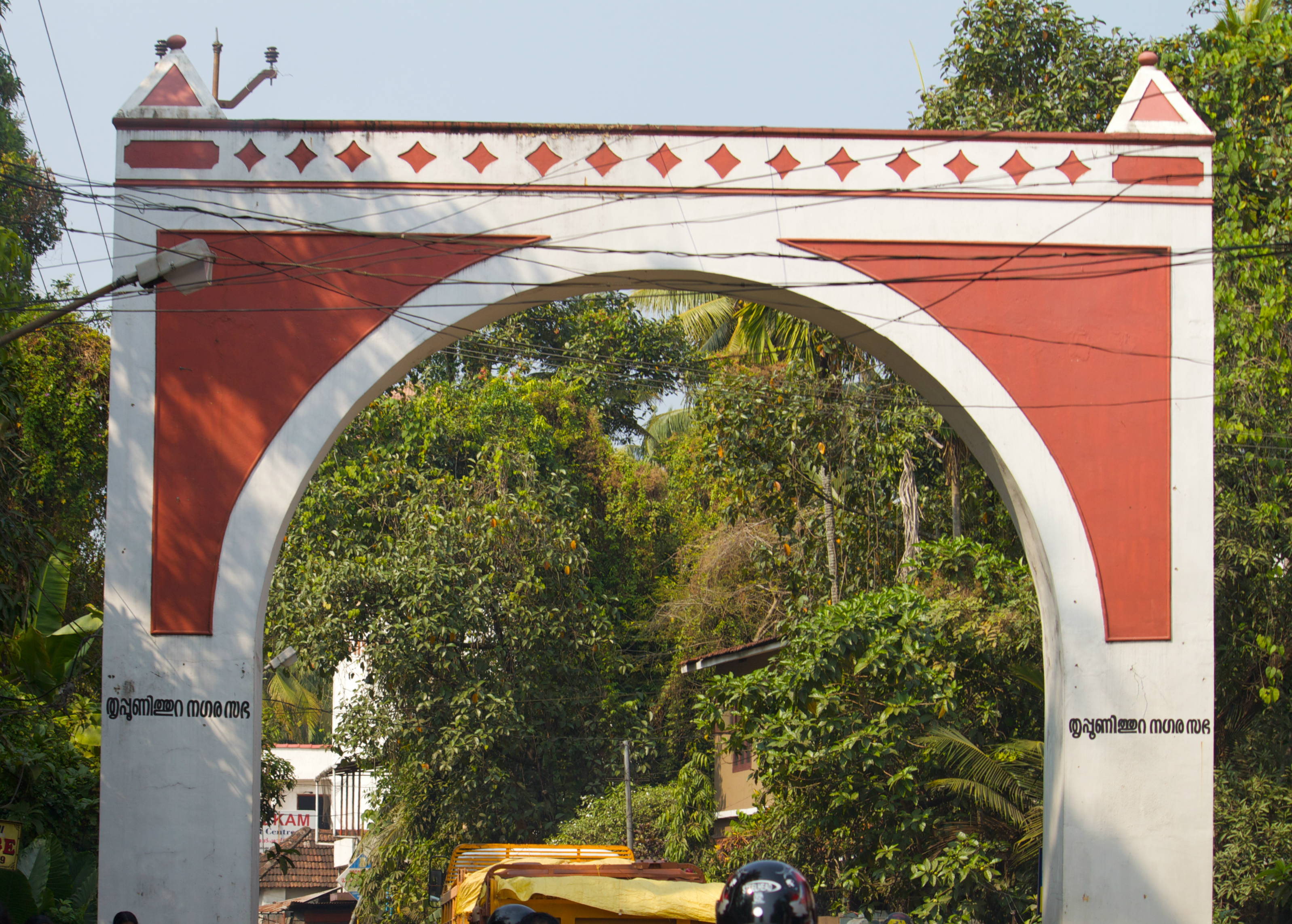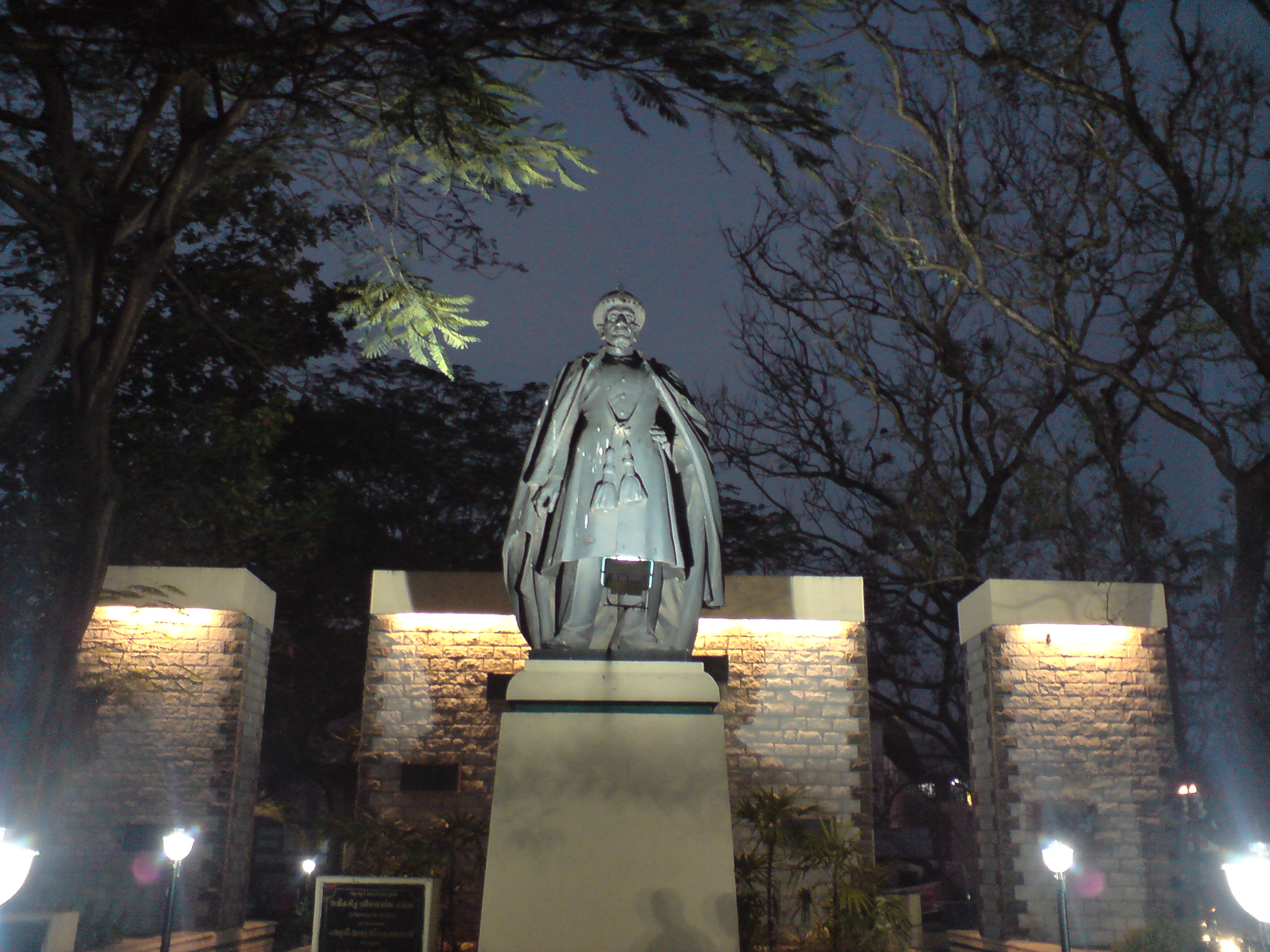|
Rama Varma Parikshith Thampuran
Darsanakalanidhi Parikshith Thampuran (died 1964) was the last official ruler of the Cochin princely state. He was also known as Ramavarman or Kunjunni Tampuran. He was born in 1876 as the son of Raman Nambutiri of Ottur House and Manku Tampuratti. On 1 July 1949, Travancore and Cochin merged, Travancore-Cochin State came into existence, and the kingdom and the rulership came to an end. He ruled the kingdom for a period of one year and then he continued as the Valliya Thampuran of Cochin. He died in 1964 while he was in Thrippunithura. He was married to Ittyanath Madathil Madhavi from Ittyanath family Villadom, Thrissur. Madhavi was the step daughter of his uncle Rama Varma XVII and Parukutty Nethyaramma (Ittyanath Madathil Parukutty). Coronation Parikshith Thampuran had his coronation on the grounds of the Durbar Hall in Ernakulam in August, 1948. This was away from the convention that the coronation was to be held at the A''riyittuvazhcha Kovilakam'' in Mattancherry. Wor ... [...More Info...] [...Related Items...] OR: [Wikipedia] [Google] [Baidu] |
Kingdom Of Cochin
The Kingdom of Cochin, named after its capital in the city of Kochi (Cochin), was a kingdom in the central part of present-day Kerala state. It commenced at the early part of the 12th century and continued to rule until 1949, when monarchy was abolished by the dominion of India. Historically, the capital of Cochin was in Kodungallur (Cranganore), but in 1341 the capital was moved to Cochin inorder to remedy a disastrous flood. By the early 15th century, Cochin lost its ability to fully defend itself. By the late 15th century, the Cochin kingdom shrank to its minimal extent as a result of invasions by the Zamorin of Calicut. When Portuguese armadas arrived in India, the Kingdom of Cochin had lost its vassals to the Zamorins, including Edapalli and Cranganore, the later of which had even been at the centre of the kingdom historically. Cochin was looking for an opportunity to preserve its independence, which was at risk. King Unni Goda Varma warmly welcomed Pedro Álvares Cabra ... [...More Info...] [...Related Items...] OR: [Wikipedia] [Google] [Baidu] |
Travancore
The Kingdom of Travancore ( /ˈtrævənkɔːr/), also known as the Kingdom of Thiruvithamkoor, was an Indian kingdom from c. 1729 until 1949. It was ruled by the Travancore Royal Family from Padmanabhapuram, and later Thiruvananthapuram. At its zenith, the kingdom covered most of the south of modern-day Kerala ( Idukki, Kottayam, Alappuzha, Pathanamthitta, Kollam, and Thiruvananthapuram districts, and some portions of Ernakulam district), and the southernmost part of modern-day Tamil Nadu (Kanyakumari district and some parts of Tenkasi district) with the Thachudaya Kaimal's enclave of Irinjalakuda Koodalmanikyam temple in the neighbouring Kingdom of Cochin. However Tangasseri area of Kollam city and Anchuthengu near Attingal in Thiruvananthapuram district, were British colonies and were part of the Malabar District until 30 June 1927, and Tirunelveli district from 1 July 1927 onwards. Travancore merged with the erstwhile princely state of Cochin to form Travancore-Cochin i ... [...More Info...] [...Related Items...] OR: [Wikipedia] [Google] [Baidu] |
Cochin
Kochi (), also known as Cochin ( ) ( the official name until 1996) is a major port city on the Malabar Coast of India bordering the Laccadive Sea, which is a part of the Arabian Sea. It is part of the district of Ernakulam in the state of Kerala and is commonly referred to as Ernakulam. Kochi is the most densely populated city in Kerala. As of 2011, it has a corporation limit population of 677,381 within an area of 94.88 km2 and a total urban population of more than of 2.1 million within an area of 440 km2, making it the largest and the most populous metropolitan area in Kerala. Kochi city is also part of the Greater Cochin region and is classified as a Tier-II city by the Government of India. The civic body that governs the city is the Kochi Municipal Corporation, which was constituted in the year 1967, and the statutory bodies that oversee its development are the Greater Cochin Development Authority (GCDA) and the Goshree Islands Development Authority (GIDA) ... [...More Info...] [...Related Items...] OR: [Wikipedia] [Google] [Baidu] |
Thrippunithura
Thrippunithura or Tripunithura (), is a prominent historical and residential region in the City of Kochi in Kerala, India. Located about 7 km (4 mi) from the city centre, Tripunithura was the capital of the erstwhile Kingdom of Cochin. The descendants of the Cochin royal family still live in the palaces here. The Hill Palace situated in Tripunithura was the palace of Maharaja of Cochin, the ruler of Kingdom of Cochin. Tripunithura is also well known for its historical cultures and worldwide famous because of Sree Poornathrayeesa Temple and the annual festival ''Vrishchikoltsawam'' that takes place at the temple. In local administration, it is a municipality named Tripunithura Municipality. In the state administrative structure, Tripunithura is part of the Ernakulam District in the state of Kerala. Etymology Some latter day Sanskrit enthusiasts describe the origin of the name to "pūrṇa vēda puri" — the town of Vedas in its entirety. Another possible origi ... [...More Info...] [...Related Items...] OR: [Wikipedia] [Google] [Baidu] |
Rama Varma XVII
Rama Varma XVII GCIE (c. 1861 – 23 May 1941) was the ruler of the Kingdom of Cochin from 25 March 1932 to 23 May 1941. Reign Rama Varma ascended the throne on the death of Rama Varma XVI. The Cochin Kochi (), also known as Cochin ( ) ( the official name until 1996) is a major port city on the Malabar Coast of India bordering the Laccadive Sea, which is a part of the Arabian Sea. It is part of the district of Ernakulam in the state of K ... harbour was expanded and the Ernakulam High Court was established during his reign. Rama Varma also showed keen interest in religious and spiritual matters. Death Rama Varma died at Chowwara on 23 May 1941. References * {{DEFAULTSORT:Varma, Rama, 17 Rulers of Cochin Knights Grand Commander of the Order of the Indian Empire 1861 births 1941 deaths ... [...More Info...] [...Related Items...] OR: [Wikipedia] [Google] [Baidu] |
Sanskrit Language
Sanskrit (; attributively , ; nominally , , ) is a classical language belonging to the Indo-Aryan branch of the Indo-European languages. It arose in South Asia after its predecessor languages had diffused there from the northwest in the late Bronze Age. Sanskrit is the sacred language of Hinduism, the language of classical Hindu philosophy, and of historical texts of Buddhism and Jainism. It was a link language in ancient and medieval South Asia, and upon transmission of Hindu and Buddhist culture to Southeast Asia, East Asia and Central Asia in the early medieval era, it became a language of religion and high culture, and of the political elites in some of these regions. As a result, Sanskrit had a lasting impact on the languages of South Asia, Southeast Asia and East Asia, especially in their formal and learned vocabularies. Sanskrit generally connotes several Old Indo-Aryan language varieties. The most archaic of these is the Vedic Sanskrit found in the Rig Veda, a col ... [...More Info...] [...Related Items...] OR: [Wikipedia] [Google] [Baidu] |
Kāvya
Kāvya (Devanagari: काव्य, IAST: ''kāvyá'') refers to the Sanskrit literary style used by Indian court poets flourishing between c.200 BCE and 1200 CE. This literary style, which includes both poetry and prose, is characterised by abundant usage of figures of speech such as metaphors, similes, and hyperbole to create its characteristic emotional effects. The result is a short lyrical work, court epic, narrative or dramatic work. Kāvya can refer to the style or the completed body of literature. Aśvaghoṣa (c. 80–150 AD), a philosopher and poet considered the father of Sanskrit drama, is attributed with first using the term. Early kāvya Although very little literature in the kāvya style written before the time of Kālidāsa (5th century CE) survives, it can be assumed from quotations in Patañjali's grammatical treatise the Mahābhāṣya (2nd century BCE), as well as from poems written on various inscriptions of the 4th to 6th centuries CE, that it dates back to ... [...More Info...] [...Related Items...] OR: [Wikipedia] [Google] [Baidu] |
Prahlādacharita
Prahlādacharitam (or Prahlādacharita) is a Sanskrit Kavya, written in ''Champu'' style by the Sanskrit scholar ''Darsanakalanidhi'' Rama Varma Parikshith Thampuran (former Maharaja of Cochin). It is the story of Asura prince Prahlāda, who was a beloved devotee of Vishnu and to save him Vishnu takes the Avatar of Narasimha. See also *Mani Madhava Chakyar Guru Mani Madhava Chakyar (IAST: ''Māṇi Mādhava Cākyār'') (15 February 1899 – 14 January 1990) was a celebrated master performance artist and Sanskrit scholar from Kerala, India, considered to be the greatest Chakyar Koothu and Kood ... Sanskrit poetry History of Kochi {{Poem-stub ... [...More Info...] [...Related Items...] OR: [Wikipedia] [Google] [Baidu] |
Rulers Of Cochin
A ruler, sometimes called a rule, line gauge, or scale, is a device used in geometry and technical drawing, as well as the engineering and construction industries, to measure distances or draw straight lines. Variants Rulers have long been made from different materials and in multiple sizes. Some are wooden. Plastics have also been used since they were invented; they can be molded with length markings instead of being scribed. Metal is used for more durable rulers for use in the workshop; sometimes a metal edge is embedded into a wooden desk ruler to preserve the edge when used for straight-line cutting. in length is useful for a ruler to be kept on a desk to help in drawing. Shorter rulers are convenient for keeping in a pocket. Longer rulers, e.g., , are necessary in some cases. Rigid wooden or plastic yardsticks, 1 yard long, and meter sticks, 1 meter long, are also used. Classically, long measuring rods were used for larger projects, now superseded by t ... [...More Info...] [...Related Items...] OR: [Wikipedia] [Google] [Baidu] |
1964 Deaths
Events January * January 1 – The Federation of Rhodesia and Nyasaland is dissolved. * January 5 - In the first meeting between leaders of the Roman Catholic and Orthodox churches since the fifteenth century, Pope Paul VI and Patriarch Athenagoras I of Constantinople meet in Jerusalem. * January 6 – A British firm, the Leyland Motors, Leyland Motor Corp., announces the sale of 450 buses to the Cuban government, challenging the United States blockade of Cuba. * January 9 – ''Martyrs' Day (Panama), Martyrs' Day'': Armed clashes between United States troops and Panamanian civilians in the Panama Canal Zone precipitate a major international crisis, resulting in the deaths of 21 Panamanians and 4 U.S. soldiers. * January 11 – United States Surgeon General Luther Terry reports that smoking may be hazardous to one's health (the first such statement from the U.S. government). * January 12 ** Zanzibar Revolution: The predominantly Arab government of Zanzibar is overthrown b ... [...More Info...] [...Related Items...] OR: [Wikipedia] [Google] [Baidu] |

.jpg)




